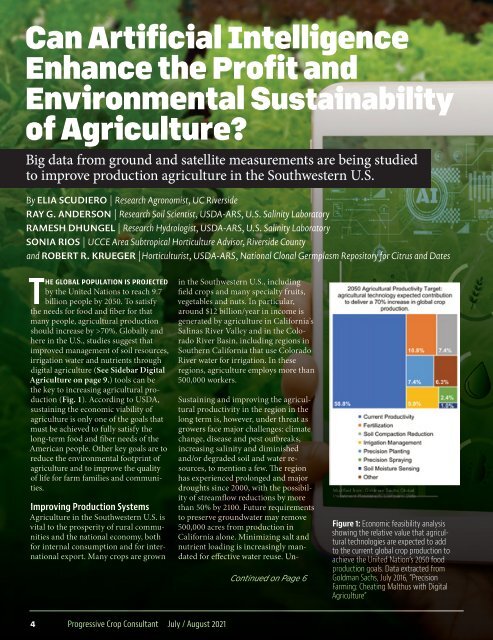PCC June July 2021 e
You also want an ePaper? Increase the reach of your titles
YUMPU automatically turns print PDFs into web optimized ePapers that Google loves.
Can Artificial Intelligence<br />
Enhance the Profit and<br />
Environmental Sustainability<br />
of Agriculture?<br />
Big data from ground and satellite measurements are being studied<br />
to improve production agriculture in the Southwestern U.S..<br />
By ELIA SCUDIERO | Research Agronomist, UC Riverside<br />
RAY G. ANDERSON | Research Soil Scientist, USDA-ARS, U.S. Salinity Laboratory<br />
RAMESH DHUNGEL | Research Hydrologist, USDA-ARS, U.S. Salinity Laboratory<br />
SONIA RIOS | UCCE Area Subtropical Horticulture Advisor, Riverside County<br />
and ROBERT R. KRUEGER |Horticulturist, USDA-ARS, National Clonal Germplasm Repository for Citrus and Dates<br />
The global population is projected<br />
by the United Nations to reach 9.7<br />
billion people by 2050. To satisfy<br />
the needs for food and fiber for that<br />
many people, agricultural production<br />
should increase by >70%. Globally and<br />
here in the U.S., studies suggest that<br />
improved management of soil resources,<br />
irrigation water and nutrients through<br />
digital agriculture (See Sidebar Digital<br />
Agriculture on page 9.) tools can be<br />
the key to increasing agricultural production<br />
(Fig. 1). According to USDA,<br />
sustaining the economic viability of<br />
agriculture is only one of the goals that<br />
must be achieved to fully satisfy the<br />
long-term food and fiber needs of the<br />
American people. Other key goals are to<br />
reduce the environmental footprint of<br />
agriculture and to improve the quality<br />
of life for farm families and communities.<br />
Improving Production Systems<br />
Agriculture in the Southwestern U.S. is<br />
vital to the prosperity of rural communities<br />
and the national economy, both<br />
for internal consumption and for international<br />
export. Many crops are grown<br />
in the Southwestern U.S., including<br />
field crops and many specialty fruits,<br />
vegetables and nuts. In particular,<br />
around $12 billion/year in income is<br />
generated by agriculture in California’s<br />
Salinas River Valley and in the Colorado<br />
River Basin, including regions in<br />
Southern California that use Colorado<br />
River water for irrigation. In these<br />
regions, agriculture employs more than<br />
500,000 workers.<br />
Sustaining and improving the agricultural<br />
productivity in the region in the<br />
long term is, however, under threat as<br />
growers face major challenges: climate<br />
change, disease and pest outbreaks,<br />
increasing salinity and diminished<br />
and/or degraded soil and water resources,<br />
to mention a few. The region<br />
has experienced prolonged and major<br />
droughts since 2000, with the possibility<br />
of streamflow reductions by more<br />
than 50% by 2100. Future requirements<br />
to preserve groundwater may remove<br />
500,000 acres from production in<br />
California alone. Minimizing salt and<br />
nutrient loading is increasingly mandated<br />
for effective water reuse. Un-<br />
Continued on Page 6<br />
Figure 1: Economic feasibility analysis<br />
showing the relative value that agricultural<br />
technologies are expected to add<br />
to the current global crop production to<br />
achieve the United Nation’s 2050 food<br />
production goals. Data extracted from<br />
Goldman Sachs, <strong>July</strong> 2016, “Precision<br />
Farming: Cheating Malthus with Digital<br />
Agriculture”<br />
4 Progressive Crop Consultant <strong>July</strong> / August <strong>2021</strong>

















